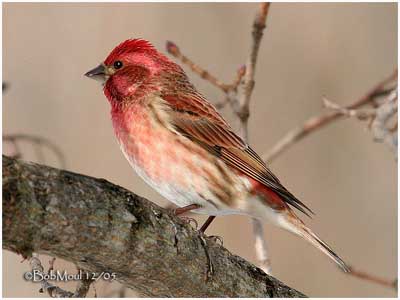
Purple Finch
Carpodacus purpureus
Passeriforme Order – Fringillidae Family
BIOMETRICS:
Length : 12 à 15 cm
Wingspan : 22 à 26 cm
Weight : 18 à 31 g
LONGEVITY: Up to 11 years
DESCRIPTION:
Purple Finch is a plump bird.

Male has head, nape, face, throat, breast, flanks and rump rose red, brightest on head and rump. Hind neck, back and scapulars are deep red, streaked with brown. Wings and tail are brown. Belly and undertail coverts are white. Tail is strongly notched. Conical bill is short, relatively thick and pointed.
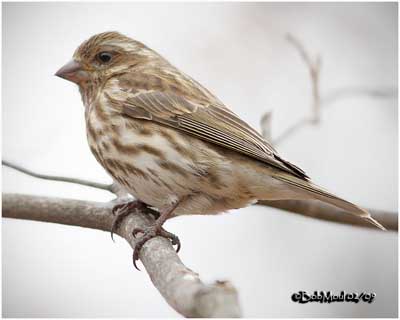
Adult female doesn’t have red colour. It has pale brown head, finely streaked with dark. We can see a dark ear patch, and white supercilium. It also has white moustache, and brown malar stripe. Upperparts are brown streaked with pale grey, except rump, tail and wings which are uniform brown. Underparts and flanks are white, heavily streaked with brown. Belly and undertail coverts are pure white.
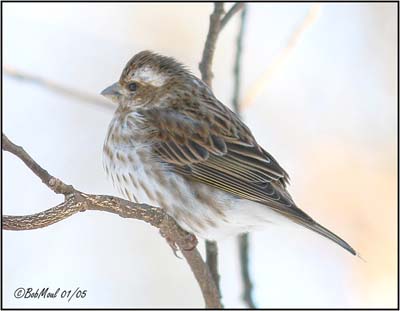
Immature looks like female. It will need two years for getting the adult plumage.
VOICE: SOUNDS BY XENO-CANTO
Purple Finch’s calls include a musical “churlee”. In flight, it is a sharp “pit”. We can also hear a short and low “tek”. Song is a series of warbling, sometimes with some mimicry of other birds. Its song is sweet and continued. It is a rich musical warbling, often ending with a descending trill.
HABITAT:
Purple Finch lives in conifer or mixed woodland edges, suburban areas, parks and orchards. It breeds in cool conifer forests, and it winters where food is available.
RANGE:
Purple Finch breeds across southern Canada and north-eastern United States. It winters in the eastern half of United States, and along the Pacific coast.
BEHAVIOUR:
Purple Finch feeds in flocks, but if they are quite friendly during their flight or sitting after food, when they are feeding, we can see some unequivocal marks of displeasure if one comes near another. Purple finch erects its head feathers and opens its mouth, and one of two birds goes away to another part of the tree.
Purple Finch feeds on outer branches, and sometimes on the ground, but often it gleans insects into foliage. It feeds on flowers by crushing the base to get nectar. With the same manner, it feeds on seeds of fruits, rather than the pulp, but fruit is damaged.
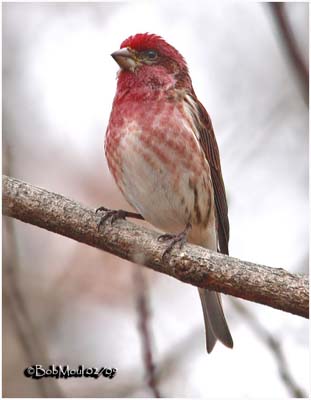
During courtship displays, Purple Finch male sings, and hops at about 6 to 12 inches high, with breast feathers puffed out, tail erected and wings dangling and vibrating and bringing nesting materials in the bill.
Purple Finches form unisexual flocks of 20 to 30 individuals after breeding. They are relatively gregarious in winter, forming flocks with other species.
FLIGHT:
Purple Finches fly compactly, with an undulating movement. They alight all at the same time, and after a moment of rest, they take wing again making a short distance, and they return to the tree from which they started.
REPRODUCTION:
Purple Finch’s nest is usually situated in a conifer, on a horizontal branch, far from the trunk, at 5 to 60 feet above the ground. Nest is made with coarse grass and weeds, and lined with fine rootlets, hair and moss. It is a neat shallow open cup. Both parents select the nest site and build the nest, but female does most of the work.
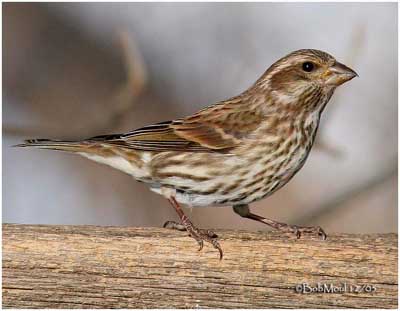
Female lays 4 to 5 pale greenish bleu eggs, spotted with brown and black on the large end. Incubation lasts about 13 days, by female. Male participates by feeding its mate during this period.
Chicks hatch altricial, helpless with little down. Initially, they are fed by regurgitated seeds, and later, by insects, small berries and juicy parts of cones of spruce pine. Young fledge 14 days later.
Pairs are territorial during the nesting period. This species produces one single clutch per season in the East, and two in the West.
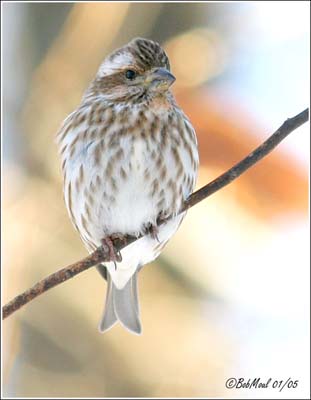
DIET:
Purple Finch feeds mainly on seeds, and tree buds and blossoms during winter. In spring, they eat insects. In summer, they feed heavily on fruits. They are fond for sunflower seeds.
PROTECTION/THREATS/ STATUS:
Populations of Purple Finches decline in many parts of its range, due to introduction of House Finch and House Sparrow too, making aggressive competitions.
Farmers accuse Purple Finches of committing great damages on the blossoms of fruit trees and they are considered as destructive birds.
Fr: Roselin pourpré
All :Purpurgimpel
Esp : Carpodaco morado
Ital : Ciuffolotto purpureo
Nd : Amerikaanse Roodmus
Suèd : Purpurrosenfink
Photographs by Bob Moul
His website :
Nature Photography
Text by Nicole Bouglouan
Sources :
FIELD GUIDE TO THE BIRDS OF NORTH AMERICA by National Geographic Society - National Geographic Society - ISBN: 0792274512
All About Birds (Cornell Lab of Ornithology)
Bird Web (Seattle Audubon Society)
Birds of Nova Scotia (Robie Tufts)
What Bird-The ultimate Bird Guide (Mitchell Waite)